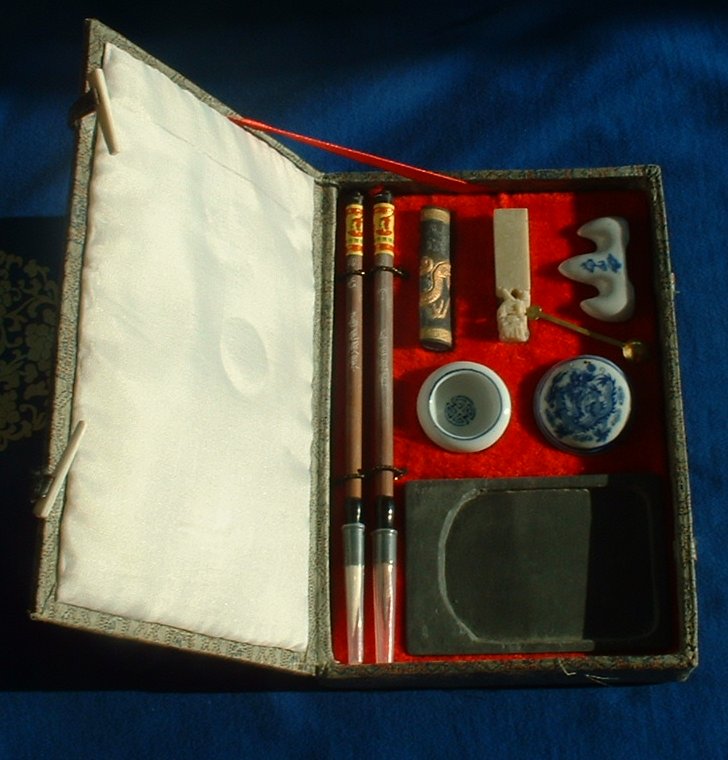Stringless guqin fan painting by Feng Chaoran (1943)
Stolen traight from www.silkqin.com/10ideo.htm on silkqin.com:Wind in the pines and a babbling brook are nature's melody. A qin was brought along, but there is no need to play it
Holy crap amazing list of Guqin pieces by the guy for MP3 download! www.silkqin.com/06hear.htm And the explanations are insane. What a dude. Ciro Santilli's hero.
Download all MP3:
wget -r -np -l 1 -A mp3 http://www.silkqin.com/06hear.htmCiro Santilli Contacted John by email in 2019 telling him to put his stuff on YouTube and offering help, and he replied, but nothing came of it unfortunately. Edit: he uploaded a bunch of videos of him playing live in 2020! www.youtube.com/user/silkqin/videos
John focuses on playing the tunes in a "historically informed performance", in particular using silk strings rather than metal ones which are used by most modern artists: www.silkqin.com/08anal/hip.htm
韦编三绝 is a chengyu that means "to study diligently", i.e. to read so much to the point that your book starts to wear down.
There is a Chinese Wiki page for this song: zh.wikipedia.org/wiki/韦编三绝 which says it dates from the early Qing dynasty
www.facebook.com/131402556881886/posts/655763214445815/ gives an origin:The silkqin.com entry: www.silkqin.com/04qart/07sqmp/57ls.htm does not mention this however.
Li Sao was composed by Cheng Kangshi in late Tang dynasty based on the poem Li Sao, authored by Qu Yuan (340-278 BC) in the Warring States period of ancient China.
Li sao performed by Guan Pinghu
. Source. Track from Master Of Traditional Chinese Music: guqinA Baidu Baike page: baike.baidu.hk/item/層層水瀾/12386243 mentions that the score was published in 1970 by Tao Yimo (陶一陌) in a eponymous score book.
Composed by Wang Huiran in 1960.
The Yi people are one of the 55 Chinese ethnic minorities officially recognized by the Chinese government.
Dance of the Yi People performed by Liu Dehai
. Source. From the album Chinese Plucked Instruments: Vol. 2 - Fishermen’s Song At South Sea: www.amazon.co.uk/Chinese-Plucked-Instruments-Fishermens-South/dp/B001HUECZQ (2004)The explosive moments presumably represent the intense rowing action of a dragon boat race competition.
TODO date composed.
One of the most flashy chinese musical instrument!
Wang Jin beats Gao Qiu theme music from The Water Margin
. Source. Pinned article: Introduction to the OurBigBook Project
Welcome to the OurBigBook Project! Our goal is to create the perfect publishing platform for STEM subjects, and get university-level students to write the best free STEM tutorials ever.
Everyone is welcome to create an account and play with the site: ourbigbook.com/go/register. We belive that students themselves can write amazing tutorials, but teachers are welcome too. You can write about anything you want, it doesn't have to be STEM or even educational. Silly test content is very welcome and you won't be penalized in any way. Just keep it legal!
Intro to OurBigBook
. Source. We have two killer features:
- topics: topics group articles by different users with the same title, e.g. here is the topic for the "Fundamental Theorem of Calculus" ourbigbook.com/go/topic/fundamental-theorem-of-calculusArticles of different users are sorted by upvote within each article page. This feature is a bit like:
- a Wikipedia where each user can have their own version of each article
- a Q&A website like Stack Overflow, where multiple people can give their views on a given topic, and the best ones are sorted by upvote. Except you don't need to wait for someone to ask first, and any topic goes, no matter how narrow or broad
This feature makes it possible for readers to find better explanations of any topic created by other writers. And it allows writers to create an explanation in a place that readers might actually find it.Figure 1. Screenshot of the "Derivative" topic page. View it live at: ourbigbook.com/go/topic/derivativeVideo 2. OurBigBook Web topics demo. Source. - local editing: you can store all your personal knowledge base content locally in a plaintext markup format that can be edited locally and published either:This way you can be sure that even if OurBigBook.com were to go down one day (which we have no plans to do as it is quite cheap to host!), your content will still be perfectly readable as a static site.
- to OurBigBook.com to get awesome multi-user features like topics and likes
- as HTML files to a static website, which you can host yourself for free on many external providers like GitHub Pages, and remain in full control
Figure 3. Visual Studio Code extension installation.Figure 4. Visual Studio Code extension tree navigation.Figure 5. Web editor. You can also edit articles on the Web editor without installing anything locally.Video 3. Edit locally and publish demo. Source. This shows editing OurBigBook Markup and publishing it using the Visual Studio Code extension.Video 4. OurBigBook Visual Studio Code extension editing and navigation demo. Source. - Infinitely deep tables of contents:
All our software is open source and hosted at: github.com/ourbigbook/ourbigbook
Further documentation can be found at: docs.ourbigbook.com
Feel free to reach our to us for any help or suggestions: docs.ourbigbook.com/#contact













